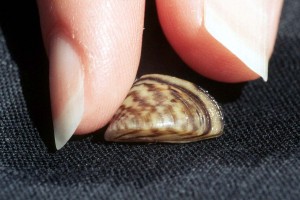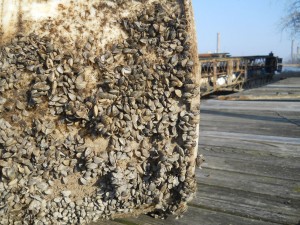Slamming Shut the Doors
A excerpt from an extensive Journal Sentinel study of Great Lakes devastation by Zebra and quagga mussels: How invasive species changed the Great Lakes forever.
A watershed moment has arrived for the Great Lakes.
After decades of regulatory paralysis, a federal judge has forced the U.S. Environmental Protection Agency to begin requiring overseas ships to decontaminate their ballast water before discharging it into the five lakes that together span a surface area the size of the United Kingdom.
Despite their vastness, for thousands of years the inland seas above Niagara Falls were as isolated from the outside world as a Northwoods Wisconsin pond. That all changed in 1959. The U.S. and Canadian governments obliterated the lake’s natural barrier to invasive fish, plants, viruses and mollusks with the construction of the St. Lawrence Seaway, a system of channels, locks and dams that opened the door for ocean freighters to sail up the once-wild St. Lawrence River, around Niagara Falls and into the heart of the continent.
Small boats had access to the lakes since the 1800s thanks to relatively tiny man-made navigation channels stretching in from the East Coast and a canal at Chicago that artificially linked Lake Michigan to the Mississippi River basin.
But the consequences of opening a nautical freeway into the Great Lakes for globe-roaming freighters proved disastrous — at least 56 non-native organisms have since been discovered in the lakes, and the majority arrived as stowaways in freighter ballast tanks.
These invaders have decimated native fish populations and rewired the way energy flows through the world’s largest freshwater system, sparking an explosion in seaweed growth that rots in reeking pockets along thousands of miles of shoreline. The foreign organisms are implicated in botulism outbreaks that have suffocated tens of thousands of birds on the eastern shore of Lake Michigan. They are among the culprits responsible for toxic algae blooms on Lake Erie that threaten public water supplies.
The hope is the new ballast discharge regulations will shut the door to new invasions.
The reality: The Environmental Protection Agency has already acknowledged they are not stringent enough to do that job.
The agency blames a lack of technology to adequately disinfect ballast tanks. Critics blame a lack of resolve in getting tough with the relatively tiny overseas shipping industry that has done so much damage to this singularly important natural resource; an average of fewer than two such ships visit the lakes each day during the Seaway’s nine-month, ice-free shipping season.
“We can do much better,” says biologist Gary Fahnenstiel, who spent his career chronicling the ecological unraveling of Lake Michigan for the National Oceanic and Atmospheric Administration. “If we really care about the lakes.”
Solving the Seaway ballast problem isn’t just about the Great Lakes, because the invaders have a history of making their way into waters across the continent. Out West, where Great Lakes invasive mussels are spreading as fast as boats are towed from lake to lake, states now have laws to throw people in jail and fine them thousands of dollars for transporting the same species Seaway freighters dumped on the continent with impunity.
Great Lakes advocates predict the bubbling frustration out West over the Seaway’s role in their troubles will erupt if — or when — Seaway ships unleash yet another invader.
Zebra Mussel
Zebra Mussels (click for larger view)
“The industry has had this grace period to find solutions,” says Phyllis Green, superintendent of Isle Royale National Park in Lake Superior. “The grace period they have been given will hit the fan when they find the next one.”
The pressure is mounting inside the Great Lakes basin as well, because even as the EPA leaves this front door to the Great Lakes cracked open, the U.S. Army Corps of Engineers is under fire from Congress to shut the back door — the Chicago canal system that is the prime pathway for Asian carp to invade the lakes. Rebuilding the natural divide between Lake Michigan and the Mississippi River basin is a project that likely wouldtake years and cost billions of dollars.
But it begs the question: Why spend all this money to close the back door if we aren’t going to shut and seal the front door as well?
Building a barrier to protect the upper Great Lakes from Seaway invaders would actually be simpler than restoring the natural watershed divide at Chicago. In fact, such a barrier already exists.
It’s called Niagara Falls.
Read the full study here.






